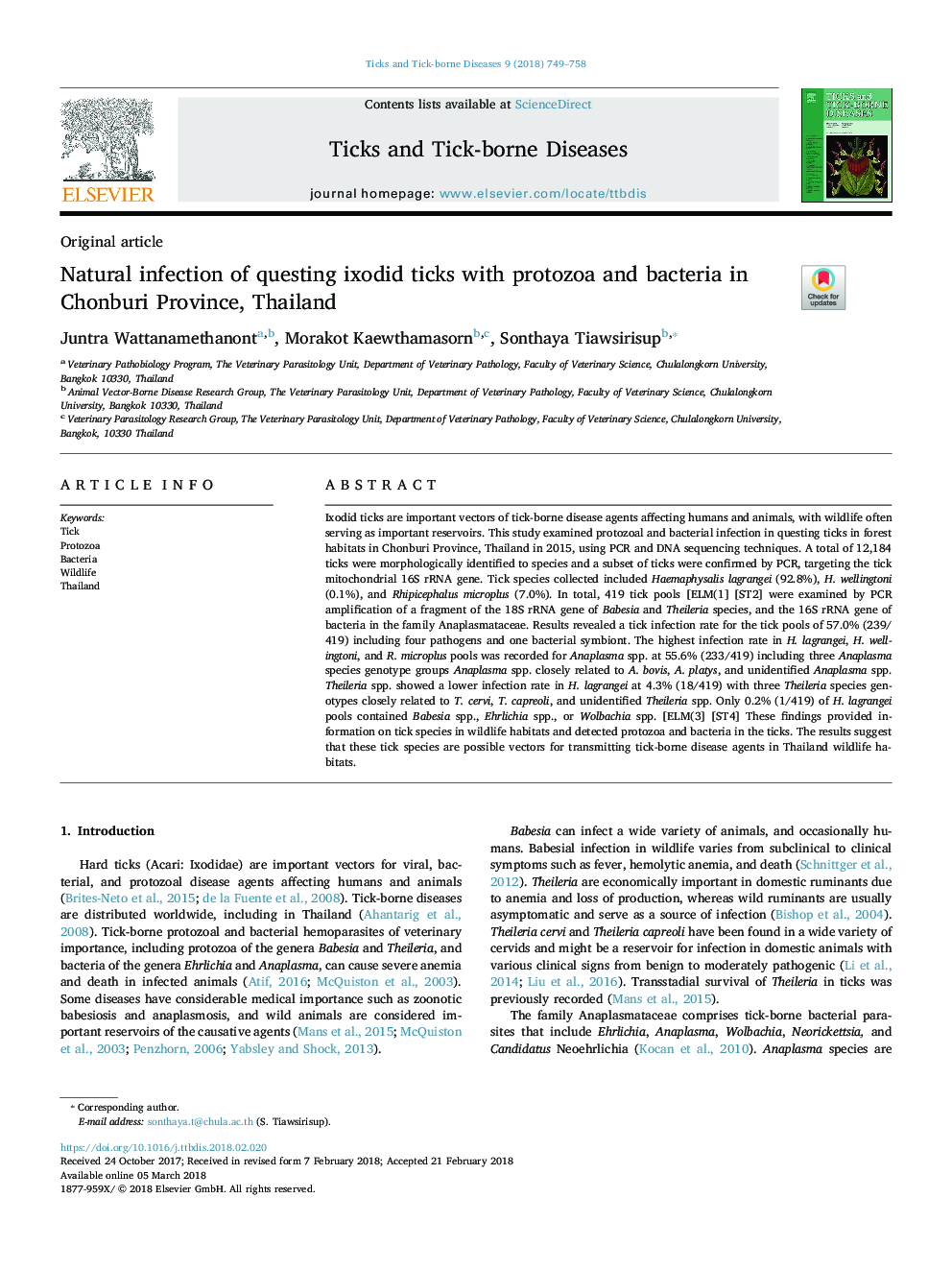| کد مقاله | کد نشریه | سال انتشار | مقاله انگلیسی | نسخه تمام متن |
|---|---|---|---|---|
| 8507377 | 1555961 | 2018 | 10 صفحه PDF | دانلود رایگان |
عنوان انگلیسی مقاله ISI
Natural infection of questing ixodid ticks with protozoa and bacteria in Chonburi Province, Thailand
ترجمه فارسی عنوان
عفونت طبیعی از کک های اگزودید با پروتوزوئی و باکتری در استان چنبوری تایلند
دانلود مقاله + سفارش ترجمه
دانلود مقاله ISI انگلیسی
رایگان برای ایرانیان
کلمات کلیدی
تیک، قاعدگی، باکتری، حیات وحش، تایلند،
موضوعات مرتبط
علوم زیستی و بیوفناوری
علوم کشاورزی و بیولوژیک
علوم دامی و جانورشناسی
چکیده انگلیسی
Ixodid ticks are important vectors of tick-borne disease agents affecting humans and animals, with wildlife often serving as important reservoirs. This study examined protozoal and bacterial infection in questing ticks in forest habitats in Chonburi Province, Thailand in 2015, using PCR and DNA sequencing techniques. A total of 12,184 ticks were morphologically identified to species and a subset of ticks were confirmed by PCR, targeting the tick mitochondrial 16S rRNA gene. Tick species collected included Haemaphysalis lagrangei (92.8%), H. wellingtoni (0.1%), and Rhipicephalus microplus (7.0%). In total, 419 tick pools [ELM(1] [ST2] were examined by PCR amplification of a fragment of the 18S rRNA gene of Babesia and Theileria species, and the 16S rRNA gene of bacteria in the family Anaplasmataceae. Results revealed a tick infection rate for the tick pools of 57.0% (239/419) including four pathogens and one bacterial symbiont. The highest infection rate in H. lagrangei, H. wellingtoni, and R. microplus pools was recorded for Anaplasma spp. at 55.6% (233/419) including three Anaplasma species genotype groups Anaplasma spp. closely related to A. bovis, A. platys, and unidentified Anaplasma spp. Theileria spp. showed a lower infection rate in H. lagrangei at 4.3% (18/419) with three Theileria species genotypes closely related to T. cervi, T. capreoli, and unidentified Theileria spp. Only 0.2% (1/419) of H. lagrangei pools contained Babesia spp., Ehrlichia spp., or Wolbachia spp. [ELM(3] [ST4] These findings provided information on tick species in wildlife habitats and detected protozoa and bacteria in the ticks. The results suggest that these tick species are possible vectors for transmitting tick-borne disease agents in Thailand wildlife habitats.
ناشر
Database: Elsevier - ScienceDirect (ساینس دایرکت)
Journal: Ticks and Tick-borne Diseases - Volume 9, Issue 3, March 2018, Pages 749-758
Journal: Ticks and Tick-borne Diseases - Volume 9, Issue 3, March 2018, Pages 749-758
نویسندگان
Juntra Wattanamethanont, Morakot Kaewthamasorn, Sonthaya Tiawsirisup,
